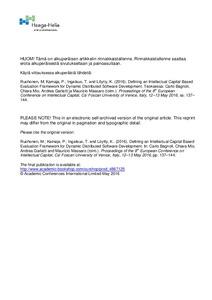Defining an Intellectual Capital Based Measurement Framework for Dynamic Distributed Software Development
Ruohonen, Mikko; Kamaja, Pekka; Ingalsuo, Timo; Löytty, Katriina (2016)
Ruohonen, Mikko
Kamaja, Pekka
Ingalsuo, Timo
Löytty, Katriina
Editoija
Bagnoli, Carlo
Mio, Chiara
Garlatti, Andrea
Academic Conferences International Limited
2016
Julkaisun pysyvä osoite on
https://urn.fi/URN:NBN:fi:amk-2018112818709
https://urn.fi/URN:NBN:fi:amk-2018112818709
Tiivistelmä
The paper presents the ongoing defining of a measurement framework with an intellectual capital (IC) perspective for dynamic distributed software development (DDSD). The topic examines building the capabilities, evaluating the efficiency and scaling up the performance of globally distributed software development teams in environments that demand high operational excellence and innovation performance.
The University of Tampere, Haaga-Helia University of Applied Sciences and the University of Helsinki are collaborating on a research project, DD-SCALE (2014-2016), with four industrial software companies working at the forefront of their industry. The objectives of the project are to investigate and develop measurement solutions, tools and work practices for managing and evaluating DDSD work. The project addresses the challenge of harnessing human and social capital assets for scaling high-performing teams to fit with high-performing organizations.
The research questions of the paper are: 1) What are the applicable dimensions, in the context of IC, of a comprehensive and scalable measurement framework for DDSD? 2) What are the relevant indicators for measuring the performance of DDSD? 3) How can a framework, its dimensions and indicators be effectively implemented in practice?
The chosen research approach is design and action research that has a qualitative emphasis. The theory perspectives of IC, performance management and distributed software development are applied. First, literature reviews were conducted. Next, data was collected from the participating companies by the means of interviews and workshops. The collected data was then analyzed by conducting a qualitative content analysis. The findings were then utilized for constructing the dimensions of the framework, identifying the measurement indicators, and designing prototypes for the implementation of the framework.
Thus far, the results include: 1) the human, structural and relational capital dimensions of the measurement framework that can be combined for examining companies on individual, team and organizational levels; 2) a categorized set of candidates for indicators; and 3) an outline of the construction as well as preliminary prototypes for implementing the framework.
The next steps of the research will include the advancement of the construction of the framework and prototypes. Examples of applicable deliverables derived from the construction will include a mobile barometer tool and an impact analysis solution for assessing DDSD work. The results will contribute to the management and development of work practices and help to realize the implementation of high performing software research and development (RD) operations within a dynamically and globally distributed setting.
The University of Tampere, Haaga-Helia University of Applied Sciences and the University of Helsinki are collaborating on a research project, DD-SCALE (2014-2016), with four industrial software companies working at the forefront of their industry. The objectives of the project are to investigate and develop measurement solutions, tools and work practices for managing and evaluating DDSD work. The project addresses the challenge of harnessing human and social capital assets for scaling high-performing teams to fit with high-performing organizations.
The research questions of the paper are: 1) What are the applicable dimensions, in the context of IC, of a comprehensive and scalable measurement framework for DDSD? 2) What are the relevant indicators for measuring the performance of DDSD? 3) How can a framework, its dimensions and indicators be effectively implemented in practice?
The chosen research approach is design and action research that has a qualitative emphasis. The theory perspectives of IC, performance management and distributed software development are applied. First, literature reviews were conducted. Next, data was collected from the participating companies by the means of interviews and workshops. The collected data was then analyzed by conducting a qualitative content analysis. The findings were then utilized for constructing the dimensions of the framework, identifying the measurement indicators, and designing prototypes for the implementation of the framework.
Thus far, the results include: 1) the human, structural and relational capital dimensions of the measurement framework that can be combined for examining companies on individual, team and organizational levels; 2) a categorized set of candidates for indicators; and 3) an outline of the construction as well as preliminary prototypes for implementing the framework.
The next steps of the research will include the advancement of the construction of the framework and prototypes. Examples of applicable deliverables derived from the construction will include a mobile barometer tool and an impact analysis solution for assessing DDSD work. The results will contribute to the management and development of work practices and help to realize the implementation of high performing software research and development (RD) operations within a dynamically and globally distributed setting.
